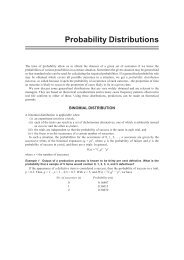International-Business-Dr-R-Chandran-E-book
International-Business-Dr-R-Chandran-E-book
International-Business-Dr-R-Chandran-E-book
Create successful ePaper yourself
Turn your PDF publications into a flip-book with our unique Google optimized e-Paper software.
187<br />
<strong>International</strong> <strong>Business</strong>- <strong>Dr</strong>. R. <strong>Chandran</strong><br />
then it is possible to bring an action or breach of confidence against the<br />
offending party. For example, an employee has an obligation to keep all<br />
information, which is given to him or her by the employer, confidential.<br />
If confidential information is disclosed to a third party out of choice<br />
then the obligation of confidentiality also passes to the third party. It should<br />
be ensured that the third party is aware of the fact that they are expected to<br />
treat the information as confidential and they agree to do so. In particle<br />
terms this agreement should be given in writing in case there is ever any<br />
dispute as to what was agreed.<br />
There is an exception to the protection of confidential information in<br />
circumstances where the dissemination of the information is deemed to be in<br />
the public interest. This is allowed, notwithstanding any obligation of<br />
confidence.<br />
The current decade has witnessed innumerable inventions in<br />
India in the field of biotechnology, agro chemicals, telecommunications,<br />
pharmaceuticals, electronics, agriculture, food processing and natural herbal<br />
medicines. Biocon, Bharat Serum, Ranbaxy, Gharda Chemicals, Cadila,<br />
United Phosphorous and Glen Mark afford to employ separate invention<br />
team and protect another team with legal expertise.<br />
PATENT COOPERATION TREATY<br />
The original Patent cooperation Treaty was signed in Washington in 1970<br />
but it has been modified many times since. The convention only came into<br />
force on 1st June 1978. This convention provides a mechanism whereby<br />
protection can be ultimately obtained in all. Or selected countries that have<br />
signed the treaty. This is carried out through a procedure which involves the<br />
filling of a single application that is subjected to a single international search<br />
and an international preliminary examination. At the end of the international<br />
preliminary examination an examination report is produced which sets out<br />
an opinion on the patentability of the invention described in the application.<br />
After completion of the examination report, the applicant has the option of<br />
proceeding with the application, or allowing the application to lapse, if the<br />
examination report is dismissive of possibilities for protection. If the<br />
applicant wishes to proceed further, the application is split into separate<br />
national applications in the countries of interest and may be subjected to a<br />
further national search and examination. The national offices function<br />
independently and may place as much weight as they wish on the opinion of<br />
the international authority, which was set out in the international preliminary<br />
examination report. Attitudes vary widely from country to country as to the<br />
Only for Private Circulation





